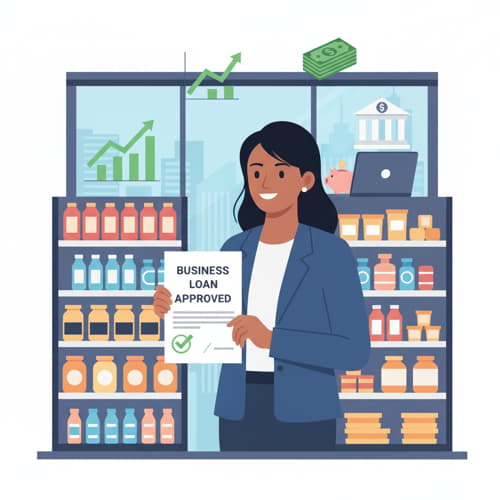Small Business Loans 2025: Best Funding Options for Entrepreneurs
Small Business Loans 2025: Best Funding Options for Entrepreneurs – Charting a Course for 2026 Growth
Introduction: Fueling the Entrepreneurial Engine : 2025 & Planning for 2026
Small businesses form the backbone of the US economy. Every entrepreneur faces the same hurdle: accessing capital. Whether a business needs funding for expansion, inventory, or simply covering payroll during slow seasons, Small Business Loans provide the essential fuel. Securing the right funding option is critical for survival and growth.
In 2025, the lending landscape for small businesses is highly dynamic. Traditional bank loans face stiff competition from fast, flexible online lenders. Looking ahead to 2026, experts predict tighter credit conditions. Entrepreneurs must understand all their options. This comprehensive guide details the best funding options for small businesses in 2025. It explains the core requirements for each. It also provides a strategic financial roadmap for navigating capital access in 2026.
## Core Business Funding Options for 2025
Entrepreneurs must choose the right loan based on their specific need, timeline, and current revenue.
| Funding Type | Best Use Case | Term Length | Speed |
| SBA Loans (SBA 7(a)) | Major expansion, real estate, working capital. | Long-term (up to 25 years) | Slow (30-90 days) |
| Term Loans | Large one-time expense (equipment, major hiring). | Fixed (2-5 years) | Medium (1-4 weeks) |
| Business Line of Credit (LOC) | Cash flow gaps, emergencies, inventory. | Revolving (Ongoing) | Fast (1-2 weeks) |
| Invoice Factoring | Immediate cash flow from accounts receivable. | Short-term (30-90 days) | Very Fast (1-3 days) |
Key Insight: The fastest money is usually the most expensive. SBA Loans offer the lowest rates. They demand the longest processing time and the strictest qualifications.
## Deep Dive into the Top Three Options
Entrepreneurs rely most heavily on these three loan types for their accessibility and versatility.
1. SBA Loans (The Gold Standard)
The Small Business Administration (SBA) guarantees these loans. This reduces the risk for the lender. As a result, lenders offer long repayment terms and the lowest interest rates. The SBA 7(a) is the most common program.
- Requirements: Borrowers need strong personal credit (680+ FICO). The business must have a clear business plan and sufficient cash flow.
- Drawback: The approval process takes significant time. It involves extensive paperwork. This is not the right choice for an immediate cash need.
2. Term Loans (The Standard Bank/Online Loan)
Term loans provide a fixed lump sum of capital. The loan is paid back in fixed installments over a set period. Banks and online lenders both offer these. Online lenders generally offer faster funding but higher rates than banks.
- Secured vs. Unsecured: Secured loans require collateral (equipment, real estate). They offer lower rates. Unsecured loans base approval purely on the business’s revenue and the owner’s credit. They carry higher rates.
- Best For: Purchasing machinery, opening a new location, or hiring a large number of employees.
3. Business Line of Credit (LOC)
The LOC offers unparalleled flexibility. It is a revolving account. The business borrows only the amount needed, up to a set limit. Interest only accrues on the drawn amount. As the business repays the principal, the funds become available again.
- Best For: Managing seasonal cash flow fluctuations, unexpected maintenance costs, or purchasing inventory in bulk for a discount.
- Key Advantage: The business only pays for the capital it uses. This makes it a perfect low-cost emergency safety net.
## Essential Requirements for 2025 Qualification
Lenders evaluate small businesses based on three core pillars. Entrepreneurs must prepare these factors before applying.
1. Personal and Business Credit Scores
Lenders almost always check the owner’s personal credit score (FICO). A score of 640 or higher unlocks most online term loans. A score of 680 or higher is essential for competitive SBA loans. The lender also reviews the business’s payment history.
2. Time in Business and Revenue
Most lenders require the business to operate for at least 1 to 2 years. They require a minimum annual revenue. For many online lenders, this minimum is typically $100,000 to $150,000. Longer time in business and higher revenue demonstrate stability.
3. Debt-Service Coverage Ratio (DSCR)
The DSCR is a critical metric. It measures the business’s available cash flow to service its current debt obligations. Lenders usually require a DSCR of at least 1.25. This means the business generates $1.25 in cash flow for every $1.00 of debt it must pay. A low DSCR makes loan approval very difficult.
## Strategy for 2026: Financial Fortification
Small businesses must prepare for a potentially tighter credit market in 2026. Entrepreneurs should execute these strategies in 2025.
1. Establish Bank Relationships Now
- 2025 Action: Start a relationship with a traditional bank or local credit union. Use their business checking accounts. Take out a small, short-term loan. Establish a flawless payment history.
- 2026 Benefit: Banks favor existing customers. This relationship significantly speeds up approval. It also opens doors to better-priced funding options in 2026.
2. Prioritize Profitability Over Growth
- 2025 Action: Focus on increasing the DSCR metric. Pay down existing debt. Document clear profitability.
- 2026 Benefit: High profitability and low debt impress lenders. This ensures the business accesses the best rates on expansion capital when needed in 2026.
3. Formalize Financial Documentation
- 2025 Action: Keep all business financial records current and organized. Maintain accurate bookkeeping. Prepare clean copies of bank statements, tax returns, and profit-and-loss statements (P&L).
- 2026 Benefit: Organized records accelerate the due diligence process. This shortens the time from application to funding.
## Final Word: Strategic Capital Access
Securing a Small Business Loan in 2025 is a strategic move, not a desperate plea. Therefore, entrepreneurs must first assess their need. They must choose the right product—SBA, Term Loan, or LOC. They must prepare their financial documents meticulously. By focusing on maintaining strong credit and high profitability in 2025, small business owners ensure resilience. They position their ventures for rapid, low-cost growth throughout 2026.
Related Posts

How Small Business Loans Help Entrepreneurs Achieve Growth

How to Get a Small Business Loan in 2025

